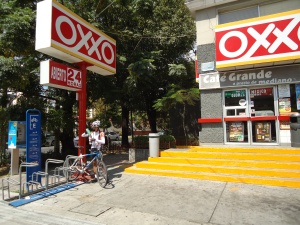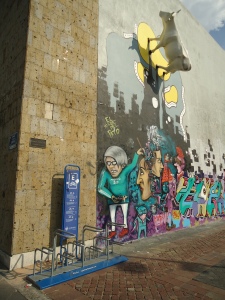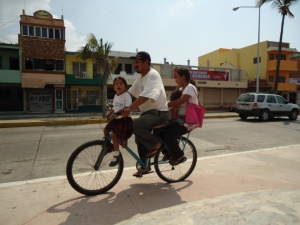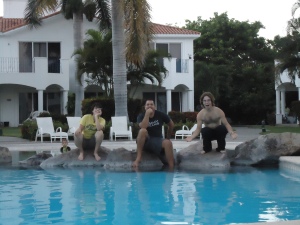
This Ciclo Puerto was built by Bicipublica and is designed for 6 bikes to fit in the space of one car parking spot. ©Ryan H.
Originally Published at http://www.activerightofway.org
When cycling activists in Guadalajara, Mexico were frustrated with the lack of bike parking in their city, they decided to build it themselves! A group of Cycling activists in Guadalajara, Mexico called Bicipublica have taken an innovative approach to the lack of cycling infrastructure in their city. These cyclists decided to start an enterprise building bike racks and selling them to local businesses. A win-win situation for the community, Guadalajara now has 230 “Ciclo Puertos” or ‘Cycle Ports’ at businesses throughout the city and the sales of the racks help fund the activists and their cycling ambitions.
We met with Mario Delgado Padilla and Sra. Itcell Islas, respectively the director and graphic designer for Bicipublica. Their organization was started from a group of Industrial Designers that would commute by bike. These designers were interested in issues regarding mobility and urban design. At their workplaces, there was no bike parking and they began to devise ideas to create efficient bike parking. Mario Padilla told us how, “Our idea was to design bike racks that were capable of fitting as many bicycles as possible in the space of one automobile.”
“Initially, our plans were without political support from the government, so we designed bike parking to sell to private businesses.” They designed a very odd looking, but efficiently designed rack that held each bike at a different height. This allowed more bicycles to be parked, by having the handlebars of each bike at a different level. Each of the Cilco Puertos could hold six bikes in a former car parking space.
Bicipublica successfully marketed, sold, and installed these Cycle Ports to private businesses around the city. Each Ciclo Puerto has a sign printed with the logo of the business, a bike map, and cycling route finding for the area around each business. Because of the City Government’s failure to envision other modes of transit, it was up to individual businesses to install infrastructure to attract customers traveling by cycle. Bicipublica filled this void and has installed 230 of these cycle ports throughout Guadalajara.

This Ciclo Puerto was purchased by Oxxo from Bicipublica and is located at one of their stores located on the weekly Via Recreativa route. ©Ryan H.
This cooperation with private business is a crucial aspect of the Bicipublica cycle plan. The organization located the racks at cafes, mini markets, restaurants, bars, & stores. Bicipublica also made an online Google map of all of the existing Ciclo Puertos and made this available on their website, www.bikla.net.
When the local municipal government became aware of these cycle racks and of the online mapping, they were excited that Bicipublica was doing their job for them and providing public cycling infrastructure by working with local businesses. The Municipality of Guadalajara agreed to help provide some initial grant funding to allow Bicipublica’s cycle parking plan to grow.
Bicipublica used the money earned from sales of the racks to start working on other ambitious plans that the city lacked the political will to pursue. One of these projects funded by the sales of the Ciclo Puertos is Bicipublica’s ambitious Bikla bike sharing network. Unlike other cycle sharing networks in the world, Bikla is designed to be self sustainable with user fees and to have minimal start up costs.
The cycling activists – social entrepreneurs of Guadalajra have many lessons to teach the world about developing affordable cycling infrastructure without political or governmental support. Bicicpublica looked to fill a void in their mobility network, turning lemons into lemonade by selling bike racks to private businesses and using the funds for their other ambitious mobility plans for Guadalajara.
For more information, find Bicipublica at http://www.bikla.net or on Facebook at BKT Bici Publica
This story was written by Ryan Hashagen & translated and edited by Lale Santelices. portlandpedals@gmail.com
We are currently travelling overland and sea from Portland, Oregon to Puerto Montt, Chile investigating Latin American cycling culture.
Stay tuned for our next story of how Bicipublica has developed a affordable and innovative bike sharing system.
More photos of Guadalajara & these travels are located at http://www.flickr.com/portlandpedalworks
When cycling activists in Guadalajara, Mexico were frustrated with the lack of bike parking in their city, they decided to build it themselves! A group of Cycling activists in Guadalajara, Mexico called Bicipublica have taken an innovative approach to the lack of cycling infrastructure in their city. These cyclists decided to start an enterprise building bike racks and selling them to local businesses. A win-win situation for the community, Guadalajara now has 230 “Ciclo Puertos” or ‘Cycle Ports’ at businesses throughout the city and the sales of the racks help fund the activists and their cycling ambitions.
We met with Mario Delgado Padilla and Sra. Itcell Islas, respectively the director and graphic designer for Bicipublica. Their organization was started from a group of Industrial Designers that would commute by bike. These designers were interested in issues regarding mobility and urban design. At their workplaces, there was no bike parking and they began to devise ideas to create efficient bike parking. Mario Padilla told us how, “Our idea was to design bike racks that were capable of fitting as many bicycles as possible in the space of one automobile.”
“Initially, our plans were without political support from the government, so we designed bike parking to sell to private businesses.” They designed a very odd looking, but efficiently designed rack that held each bike at a different height. This allowed more bicycles to be parked, by having the handlebars of each bike at a different level. Each of the Cilco Puertos could hold six bikes in a former car parking space.
Bicipublica successfully marketed, sold, and installed these Cycle Ports to private businesses around the city. Each Ciclo Puerto has a sign printed with the logo of the business, a bike map, and cycling route finding for the area around each business. Because of the City Government’s failure to envision other modes of transit, it was up to individual businesses to install infrastructure to attract customers traveling by cycle. Bicipublica filled this void and has installed 230 of these cycle ports throughout Guadalajara.
This cooperation with private business is a crucial aspect of the Bicipublica cycle plan. The organization located the racks at cafes, mini markets, restaurants, bars, & stores. Bicipublica also made an online Google map of all of the existing Ciclo Puertos and made this available on their website,www.bikla.net.
When the local municipal government became aware of these cycle racks and of the online mapping, they were excited that Bicipublica was doing their job for them and providing public cycling infrastructure by working with local businesses. The Municipality of Guadalajara agreed to help provide some initial grant funding to allow Bicipublica’s cycle parking plan to grow.
Bicipublica used the money earned from sales of the racks to start working on other ambitious plans that the city lacked the political will to pursue. One of these projects funded by the sales of the Ciclo Puertos is Bicipublica’s ambitious Bikla bike sharing network. Unlike other cycle sharing networks in the world, Bikla is designed to be self sustainable with user fees and to have minimal start up costs.
The cycling activists – social entrepreneurs of Guadalajra have many lessons to teach the world about developing affordable cycling infrastructure without political or governmental support. Bicicpublica looked to fill a void in their mobility network, turning lemons into lemonade by selling bike racks to private businesses and using the funds for their other ambitious mobility plans for Guadalajara.
Tags: bbl, Bicipublica, businesses, ciclo puertos, gdl, mexico
For more information, find Bicipublica at http://www.bikla.net or on Facebook at BKT Bici Publica
This story was written by Ryan Hashagen & translated and edited by Lale Santelices. portlandpedals@gmail.com
We are currently travelling overland and sea from Portland, Oregon to Puerto Montt, Chile investigating Latin American cycling culture.
Stay tuned for our next story of how Bicipublica has developed a affordable and innovative bike sharing system.
More photos of Guadalajara & these travels are located at http://www.flickr.com/globalgreenways
Originally Published at http://www.activerightofway.org




















